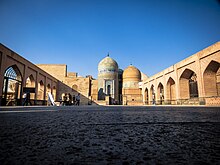Sheikh Safi al-Din Khānegāh and Shrine Ensemble
| UNESCO World Heritage Site | |
|---|---|
 | |
| Location | Ardabil, Ardabil Province, Iran |
| Criteria | Cultural: (i), (ii), (iv) |
| Reference | 1345 |
| Inscription | 2010 (34th Session) |
| Area | 2.1353 ha (5.276 acres) |
| Buffer zone | 13.0616 ha (32.276 acres) |
| Coordinates | 38°14′55″N 48°17′29″E / 38.24861°N 48.29139°E |
Sheikh Safi al-Din Khānegāh and Shrine Ensemble (Persian: مجموعه آرامگاه و خانقاه شیخ صفیالدین) is the tomb of Sheikh Safi-ad-din Ardabili located in Ardabil, Iran.[1] In 2010, it was registered on the UNESCO World Heritage List.[2]
History
[edit]Sheikh Safi, a leader of an Islamic Sufi order established by the Safavids, was born in Ardabil where this complex is located. The Safavids valued the tomb-mosque form, and the tomb with its mausoleum and prayer hall is located at a right angle to the mosque. The buildings in the complex surround a small inner courtyard (31 by 16 meters). The complex is entered through a long garden.[3]

The Mausoleum of Sheikh Safi, in Ardabil, was first built by his son Sheikh Sadr al-Dīn Mūsā, after Sheikh Safi's death in 1334.[4] It was constructed between the beginning of the 16th century and the end of the 18th century. The mausoleum, a tall, domed circular tower decorated with blue tile and about 17 meters in height; beside it is the 17th-century Porcelain House preserving the sanctuary's ceremonial wares.[3] Also part of the complex are many sections that have served a variety of functions over the past centuries, including a library, a mosque, a school, mausolea, a cistern, a hospital, kitchens, a bakery, and some offices. It incorporates a route to reach the shrine of the sheikh divided into seven segments, which mirror the seven stages of Sufi mysticism. Various parts of the mausoleum are separated by eight gates, which represent the eight attitudes of Sufism.[5][6]
-
An etched figure of a giant hand, in Safi-ad-din Ardabili Mausoleum, showing Twelver Shi'a sign of Panj-tan-e Āl-e Abā
-
A decorative stone sculpture of Safavid era, decorated with attributes of God (reading ya hannan, ya mannan) (O merciful, O generous )
Architectural features
[edit]The present complex, called the tomb of Sheikh Safi al-Din Ardabili, includes the outside of the tomb, the portal, the great courtyard, the portico, the grave of Sheikh Safi al-Din itself, the Women-only space (Andaruni, a term used in Iranian architecture), the grave of King Ismail I, Chini-house which has beautiful Stuccos and several precious wooden and silver doors, The Janatsara Mosque, Khanqah, cheraqkhaneh (house of lights), Chellehkhaneh (a praying room), the burial ground of the martyrs and other belongings.[7]
The tomb of Sheikh Safi al-Din Ardabili is a cylindrical tower topped off with a short dome. Beneath the dome, there is a vault that is one of the valuable works of the tomb, and around the edge of it, there is an inscription carved in the Reqa style calligraphy. One of the unique features of the tomb of Sheikh Safi al-Din Ardabili is that it contains several valuable works of art on different themes of art, including the perfect type of mosaic tiles, vaulted tiling with painting, Stuccos, beautiful precious inscriptions, and the wonderful calligraphy of the greatest calligraphers of Safavid era (Mir Emad Hassani, Mir Qavamoddin, Mohammad Ismail, etc.), precious wood-carvings, silversmithing, illuminated manuscripts and goldsmithing, paintings, using a different style of stonework, etc.[8]
Gallery
[edit]-
View of tomb in 2022
-
Sheikh Safi Al din Tomb
-
Mausoleums with blue tile
-
The inner courtyard and the mosque
-
Persian Islamic art on the Iwan at the tomb
-
Ceiling of the tomb
-
Statue of Sheikh Safi-ad-din Ardabili
-
library
References
[edit]- ^ "Sheikh Safi al-din Khānegāh and Shrine Ensemble in Ardabil - UNESCO World Heritage Centre". Whc.unesco.org. 2010-07-29. Retrieved 2010-08-02.
- ^ Source: Unescopress. "World Heritage Committee inscribes seven cultural sites on World Heritage List | United Nations Educational, Scientific and Cultural Organization". Unesco.org. Retrieved 2010-08-02.
- ^ a b Ching, D.K. (2007). A Global History of Architecture. Hoboken, New Jersey: John Wiley & Sons, Inc. pp. 479. ISBN 978-0-471-26892-5.
- ^ Square Kufic
- ^ Sheikh Safi al-din Khānegāh and Shrine Ensemble in Ardabil - UNESCO World Heritage Centre
- ^ tehran times : Two more Iranian sites added to UNESCO World Heritage List
- ^ Correia, Antónia; Kozak, Metin; Rodrigues, Ana Isabel (6 September 2019). Experiencing Persian Heritage: Perspectives and Challenges. Emerald Group Publishing. p. 38. ISBN 978-1-78754-812-1.
- ^ "Sheikh Safi al-Din Ardabili's Shrine - in 2 iran UNESCO World Heritage List". 21 May 2019.
http://www.irantourismcenter.com/?page_id=7130
Further reading
[edit]- Melville, Charles (2020). "Shah ʿAbbas's Patronage of the Dynastic Shrine at Ardabil". Muqarnas Online. 37 (1): 111–138. doi:10.1163/22118993-00371P05.































